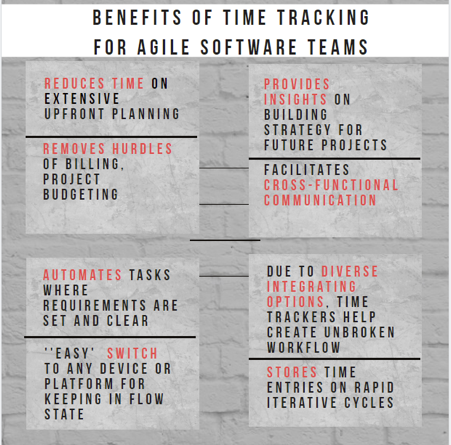

This guest post is from Alla Chernets at Tmetric, an online time-tracking tool that allows users to track the time spent on various projects and analyze productivity.
The first fact about time tracking that springs to mind is that it is the least exciting thing within the development cycle. Not many developers in sprints think: ‘Oh, cannot wait for tracking time on EVERY task!’
And there is a justification behind this skeptic view. After all, in agile it is all about two things: what is next and what is left.
Right? Well, wrong.
Agile project management has been in practice in the software development sector for almost 20 years, and Agile statistics confirms its growing popularity as the widely applied technique in SDLC.
In particular, opting for the Agile framework brings more successful project completion in 28% cases compared to projects where teams were using the traditional methods.
Overall, the agile approach allows to perform and timeline the project with prioritized tasks assigned to different team members.
Why is time tracking a must-have workflow component for agile software teams?
Because agile, among other things, is about the high level of adjustment to changes, and tracking and collecting time data bring consistency to the process that otherwise might result in interim mistakes, catastrophic mismanagement and failed sprint.
Agile in practice means that at all the stages including design, analysis, or testing, the process goes with lots of room for changes in mind.
Naturally, to avoid time loss and ensure the smooth workflow, time tracking software comes as an optimal solution.
Agile approach implies working in self-organizing teams. They usually create the product while constructing the development process around test and result-oriented strategies as the basics.
In either scenario, the team aligns its work with the specific requirements, and in both cases, time is one of the crucial factors. The team may consider estimating in story points for defining tasks complexity. But then, within a sprint plan story points will relate to the hours allocated to work.
To meet the multiple micro deadlines and harness development cycle time, the team creates estimates for conducting tests (it will define the quality of the team’s work) and achieving the result (it will eventually define the value of the product).
For the projects incorporating the recurring tasks, time estimates can be easily calculated by data kept for the previously performed projects, and it is where automatic time trackers can come handy as the verified metrics can set the subsequent estimates.
In other cases, creating estimates is guided by professional experience and intuition.
Additionally, including more people into a team increases communication volume so, for the sake of keeping the high collaborative level within a big team, communication overhead incorporates into time estimates of the agile team. To avoid uncertain numbers or prevent time overrun, the time data on previous sprints is taken into consideration.
The development cycle is not a process rigidly set once and for all in terms of time: at some stages of the project, waiting for other team members is a part of working in collaboration.
In this case, time tracking will be an effective instrument of monitoring team performance and analyzing estimates against actual entries to see when the process blockages were justifiable. For example, TMetric time tracker that lots of software teams favor packs metrics on detailed time entries and activity level in one neat timeline, which gives the clear view of time consumption alongside with a team member performance.
Upon completing estimates creation, the team starts tracking the project. Later on, teams measure how the actual work compares to their original estimation.
In Agile methodology, the excellence of design and attention to technical detail are two major principles. Furthermore, a final product satisfying the needs of the client is the primary source for evaluating the overall success of the project. To ‘glue’ stages and make workflow seamless, time tracking comes as one the essentials. Upon the development completion, the collected time entry data make the evaluation truly effective by providing the relevant information on the accurate assessment of the performance.
Factors supporting time tracking in Agile evaluation:
Time tracking software ideally fits in the Agile software development as both a team and a time management tool that enables you to streamline the collaborative efforts of the software team.
At the stage of evaluation, there is no better way than bringing time measurements to the table as they are the only accurate way to measure the pace of work.
Time metrics stored in the time tracking records maintain the valuable information that is easy to transform into specific data for analyzing and understanding the work that has been done and the overall capabilities of the team.
Generally, time tracking records will be helpful for evaluating:
In particular, within Agile evaluation, automatic time tracking data enables developers and managers to have the validated clear analysis of time utilized on:
The development process must adapt to changes in the market environment, that is highly oriented to customers’ needs: under these conditions, time tracking works as a practical solution in agile teams’ work that can prevent issues with prioritizing and extensive planning.
Though time tracking in agile projects used to be optional, now it shifted to the domain of must-haves in project performance as it became apparent that the deadline is not the only component determining the project success, and in most cases, lack of metrics related to time utilization translates into unavoidable management pitfalls and misinterpretation by clients.
So regardless of development complexity, time tracking enhances the agile software teams performance.
Practically speaking, time tracker ‘articulate’ figures for ensuring time management as an important factor of success of software development projects.

Agile software teams can take advantage of time tracking for:
The time tracker applied in agile software team collaboration benchmarks the progress of an individual. It allows to see team velocity and assess the data in burn-down charts to ensure precision and adaptability to changes in sprint length.
So regardless of development complexity, time tracking enhances the agile software teams performance due to providing the specific metrics of forecasting value. Afterward, it also helps identify bottlenecks in the process for further preventing any kind of time management pitfalls.
By obtaining metrics measuring the cycle time of separate stories the agile software teams can work more productively. Therefore, applying time tracking software is an effective method of increasing velocity and responsiveness by enhancing agility with specific result-driven metrics.
Though time tracking in agile projects used to be optional, now it shifted to the domain of must-haves in project performance as it became apparent that the deadline is not the only component determining the project success, and in most cases lack of metrics related to time utilization translates into unavoidable management pitfalls.
Time tracking shifts focus from calculating time to investing efforts. The fact that you can see accurate time consumption data for accomplished tasks at the end of each sprint by using time tracking is what creates accountability and builds solid grounds for efficient collaboration.
Alla Chernets has been providing informative reads for TMetric blog for a year. Her articles focus on productivity and explorations of the ways to achieve the best results and get more agile.
Category: Integrations